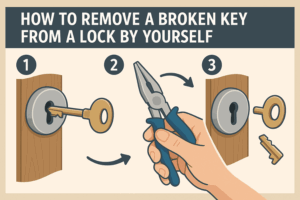A broken key inside a lock can feel like the end of the world—especially when you’re rushing out the door or trying to get inside your home, car, or office. But don’t panic just yet. While calling a locksmith is always a smart option, there are several techniques you can try before picking up the phone. With the right tools and a bit of patience, removing a broken key from a lock is something many people can do on their own.
In this guide, we’ll walk you through step-by-step instructions, precautions to take, and the tools you’ll need to attempt this repair safely and effectively.
Step 1: Assess the Situation
Before you do anything else, take a moment to evaluate the severity of the problem. Every lock and key situation is unique, and your success in removing the broken piece depends on a few key factors:
Key Visibility
- Is any part of the key sticking out of the lock? If a small fragment is visible, you’re in luck—it might be possible to grab it with simple tools like tweezers or pliers.
- Is the entire key inside the lock? If so, you’ll likely need a specialized tool or technique.
Lock Position and Type
- Vertical vs. Horizontal: If the lock is positioned vertically, gravity may help during removal. If it’s horizontal (common in cars and some doors), you may need to take a different approach.
- Type of Lock: Is it a deadbolt, door knob, padlock, or vehicle ignition? Some locks are easier to work with than others.
Condition of the Lock
-
Is the lock rusty, dirty, or stuck? If yes, it might take more effort and lubrication to loosen the broken piece.
Understanding the scenario will help you choose the best method and avoid damaging the lock further.
Step 2: Apply Lubricant
Friction is your enemy in this process. The tighter the broken key is wedged inside the lock, the harder it will be to remove. Applying lubricant is an essential first step.
Choosing the Right Lubricant
- Use graphite powder or a dry Teflon-based spray—these are ideal because they won’t attract dirt or gunk up the lock over time.
- Avoid oil-based lubricants like WD-40 for this task. While they may work in the short term, they tend to attract dust and grime that can damage the lock later.
How to Apply
- Insert the straw applicator into the keyhole and spray a small amount directly inside.
- Let the lubricant sit for 1–2 minutes so it can work its way into the lock mechanism.
This step may make it significantly easier to slide out the broken key, especially if it’s stuck due to rust or debris.
Step 3: Use Tweezers or Needle-Nose Pliers
If a portion of the broken key is visible and sticking out of the keyhole, this may be your easiest option.
How to Use This Method
- Grab a pair of precision tweezers or needle-nose pliers.
- Gently grip the exposed metal—avoid pushing it deeper.
- Slowly wiggle it back and forth, applying light pressure as you try to pull it straight out.
Tips for Success
- Make sure your tool is thin enough to avoid damaging the lock cylinder.
- If the key is flush with the lock surface or recessed, skip this method to avoid accidentally lodging it deeper inside.
When to Skip This Step
-
If the key is barely visible or difficult to grip, don’t force it. You risk bending or jamming the fragment deeper.
Step 4: Use a Broken Key Extractor Tool
Broken key extractor tools are inexpensive, easy to use, and designed specifically for this purpose. You can buy them online or at most hardware stores.
How They Work
- They’re thin metal tools with a barbed or hooked end that can grip the key’s grooves.
- Insert the extractor alongside the key fragment into the lock.
- Twist and maneuver it slightly to catch the key’s notches.
- Once hooked, slowly pull outward with gentle, steady pressure.
Types of Extractors
- Single-hook: Good for pulling out keys that are loosely jammed.
- Double-hook or saw-tooth: Better for gripping deeper or more tightly wedged pieces.
Patience is Key
This process can take several tries. If it’s not catching the first time, remove the tool, reposition it, and try again.
Step 5: Use a DIY Alternative (Jigsaw Blade or Paperclip)
If you don’t have access to a commercial extractor tool, you can improvise with everyday household items.
Using a Jigsaw Blade
- Choose a small jigsaw or scroll saw blade—the kind used for intricate cuts.
- Snap off the end to make it short enough to fit into the keyhole.
- Insert the blade along the side of the key and twist slightly to hook it on the teeth.
- Pull slowly to extract the key.
Using a Paperclip
- Unfold the clip and bend one end into a small hook.
- Slide it carefully into the lock next to the key.
- Wiggle it gently until you catch a groove, then pull outward.
These methods are less precise than a proper extractor but can work in a pinch.
Step 6: Tap the Lock Gently (If Possible)
If the lock is not attached to a door (such as with padlocks), you may be able to shake the key loose using gravity and vibration.
How to Do It
- Hold the lock with the keyhole facing downward.
- Tap the lock lightly on a wooden surface (to avoid damage).
- While tapping, gently shake or twist the lock to encourage the broken piece to slide out.
Important Caution
-
Never hit the lock hard or against metal—this can damage internal pins or jam the key deeper.
This method is often used in combination with a lubricant to increase your chances of success.
Step 7: Clean and Test the Lock
Once you’ve successfully removed the broken piece, your job isn’t quite done. You need to ensure the lock is clean and fully functional.
Final Steps
- Check for remaining debris or metal shards inside the lock.
- Use a can of compressed air or a clean, dry cloth to clear out any loose particles.
- Test the lock with a new or spare key to make sure everything operates smoothly.
If the key was difficult to remove or the lock still feels sticky or unresponsive, it may need professional servicing.
When You Should Call a Professional Locksmith
Although DIY methods can be effective, they won’t always work—especially in more complex or sensitive situations.
Contact a Locksmith If:
- The key is completely inside the lock with no visible end.
- You’ve tried multiple methods and nothing has worked.
- The lock is damaged, sticky, or not functioning even after removal.
- The key is broken inside a vehicle ignition or electronic lock system—these are delicate and expensive to replace if mishandled.
Trying too many methods without the right tools or expertise can lead to bigger repair bills later on. Sometimes, calling a locksmith is the faster, safer, and more cost-effective choice.
Need Help? Contact Major Island Locksmith
If you’ve tried everything and the broken key is still stuck—or if you simply want the problem solved quickly and professionally—Major Island Locksmith is here to help.
Why Choose Us?
- Experienced Technicians: Our locksmiths have years of experience dealing with all kinds of key and lock issues.
- Fast Response: We offer emergency services and prompt arrivals for your convenience.
- Affordable Rates: No surprise charges—just honest pricing and professional service.
- Comprehensive Services: From residential to automotive to commercial locksmith needs, we’ve got you covered.
Areas We Service
When you’re dealing with a broken key or a lockout situation, time is of the essence, and you need help fast. At Major Island Locksmith, we understand the urgency, which is why we proudly offer fast, professional locksmith services across a wide service area. Whether you’re in Franklin Square, Garden City South, Stewart Manor, New Hyde Park, Floral Park, East Rockaway, Lynbrook, Woodmere, or Hempstead, our team is ready to respond quickly to your call and provide the assistance you need to get back on track.
Don’t let a broken key disrupt your day. Whether you’re locked out of your home, car, or office, let Major Island Locksmith get you back in quickly and safely.
Call us today 516-779-6698 or Email us at info@majorislandlocksmith.com to schedule service or request emergency assistance.




